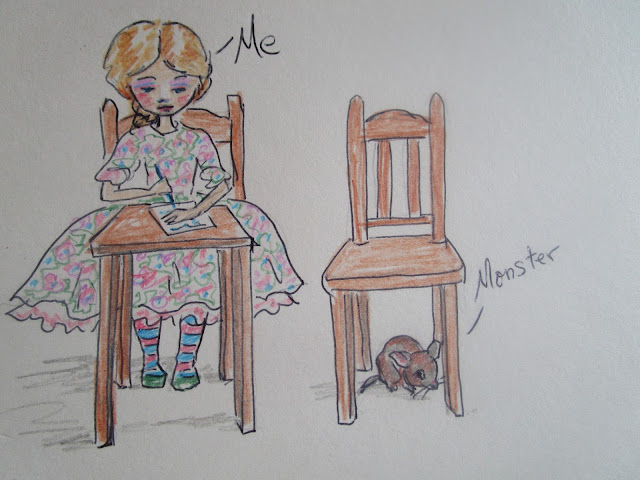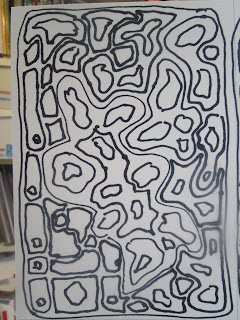As mentioned previously, my sister has asked for some help in drawing faces to augment a class she is taking, so I am putting my thoughts down here. This will likely be on-going.
Drawing in General
First, to enjoy the process of drawing, or making any art, one must get rid of the
misconceptions.
- Wrong: there is
one right way to draw (or sing or bake or dance).
Different ways are for different outcomes, so all or any can be valid. Meaning; your way of doing things can be as good as all the other ways that others do. And, on the other hand, just because you now think that (fill in the blank______) is not "right" or "sophisticated" or worthwhile, doesn't mean you can't learn to appreciate it. This refers to things like representational or non-representational depictions, abstract or realistic, decorative or portrait faces, markers or oil paints, and all those comparisons. Each has its place.
-Wrong: One must
not be restricted by rules and limits, or ones creativity will be squelched. Absolutely not. First one must learn the rules of the road, the techniques of the trade, and the moves of the music, before she can make art out of anything. The mind absorbs the knowledge while the hands are practicing the skills, until the two are melded, and then - only then, when the basics are in the automatic mode - can the creative expression of the art come forth. Nobody is going to dance
Swan Lake who doesn't know her foot positions or sculpt a
Pieta who hasn't chiseled tons of marble, and so on. So you need to study the basics - really well!
Second, you need some
basic materials and have them with you at all times and use them a lot! If you are not having to replace pencils and paper stacks and markers on a frequent rotation, you are not doing enough practice. Enough said.
You should have these:
+ Pencils of various hardnesses.
+ An eraser, that you will rarely use
+ A fine tip and a broad tip black marker
+ A white marker/gel pen/paint pen (that covers layers of other media)
+ Colored pencils of good quality, waxed based for top work, or watercolor pencils for underwork
+ Paper, lots of it, any kind, all kinds; it needn't be expensive. Use the blank backs of scrap for your practice pieces.
Nice to have if possible:
+ Acrylic paints and brushes. Craft paints are acceptable for starters.
+ A couple of good brushes, that you maintain scrupulously clean. Rounds in 2 and 10, and a flat
will suffice at first.
+ Tracing paper, carbon paper, or a light box, for transferring patterns
+ Some stencils in forms that you like. You can cut your own by copying patterns that you like onto stiff paper and cutting them out with a craft knife.
+ Rubber stamps or acrylic mounted stamps and ink pad(s) for decorative drawings
+ Any other drawing media, like pastels, paint markers, charcoal pencils, Conte crayons, and so on.
Keep all this handy, so a
carrying bag will want to go with you - everywhere.
 |
| Always have a sketchbook along. You'll never regret taking the time to use it. These are a few of mine from over the years, from trips to Germany, Ukraine, and Japan, and our own country. |
Third, get in your head the
bones of what you are doing. If something doesn't have the bones right, nothing will work well. In languages that is the grammar. In music it is the timing and key. In drawing faces, it is the skeleton and muscles. Look at the major forms and learn them. It really helps.
 |
| Ya' aut'er know this... |
 |
| The bones and hollows |
 |
| Note the planes on the right side of the picture, that become the form on the left side |
Fourth, learn the fundamental
proportions of the head. This will vary by sex and age (which we will look at later, so concentrate on a young woman's face proportions for now).
Fifth, do not concentrate on how to make the eyes or mouth or any other feature
detail, until you have become competent in the major forms. (I have seen many people who have put hours of toil into the most amazingly detailed drawing of meticulous features on a face/horse/figure with wrong overall proportions. As with everything, you need to get the big picture right, then the details will be much easier to pull off - in fact, you sometimes don't even need details and it will still be lovely.
 |
| How few marks you need to say something |
Practice One -
Scribble, yes, really. You know that is what you did as a baby, so it is necessary to all good beginnings. Scribbling is a valid way to draw. (I personally do all my drawings in that way.) Some people find it difficult, because they like control, and they will always go back to a single-line type of drawing, which is fine for their temperament; but everyone should practice scribbling anyway. It loosens the muscles, relaxes the body and mind, and allows you to make marks without expecting a masterpiece at the beginning (you can have one at the end - some day).
Process:
Gather paper,
pencil,
a couple of colors in any drawing media (markers are good)
and some relaxing place,
music optional,
good light imperative.
Resource: Do not attempt
to do your drawings without resource material
. It is like having children teach each other and they all end up ignorant. Something must be added to ones brain to make learning happen. Always use resources: a picture to copy, a model (that person over there who is doing nothing won't mind sitting for you), or yourself in the mirror.
For this practice use
a picture of a full front female face (or two or three) and one of a three-quarter view with some shadow.
Method:
Look for awhile
at the picture and note the
feature placement,
shadowed areas, and
spacing between parts.
Pick up your drawing implement and
look at your paper, envisioning the face on it. Yes, really, do it.
Put the drawing implement (I'll say pencil from now on, but it might be something else you are using)
on the paper and
keep it moving and on the paper as you look back and forth from the picture to your drawing. Stop when you want to, but not too soon.
Goal:
You are trying to indicate areas of
darkness, some deeper, some mid-tone, with other areas left the white of the paper. This
is training your
eyes to see lights and darks, your
hand to translate from the eyes without belaboring, and your
psyche to give yourself breathing room.
Repeat: Always you must repeat. It is the only way to learn. Do
many.
Then practice with
two or three colors, starting with the lightest, and adding the middle tone over it, but in fewer places, then putting a little of the darkest in some places (you can pick up your marker a couple of times with the darkest, but keep it scribbled.)
Next: Not-scribbled lines in doodles. This will be prettier.
"Seen Today," I'll show you tomorrow, because this is already too long and it is late here.

























































